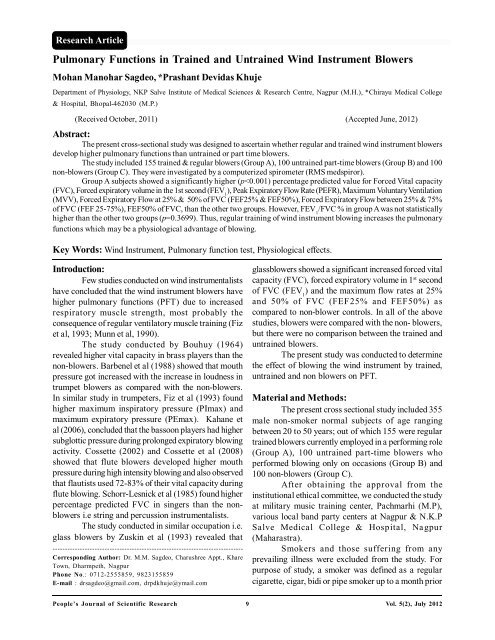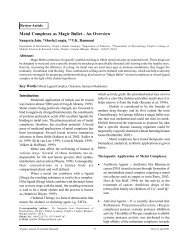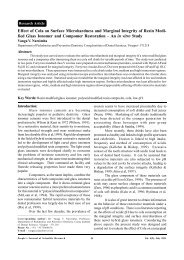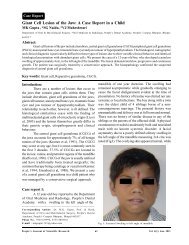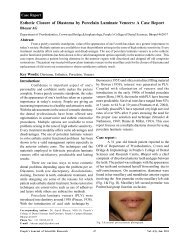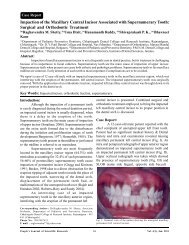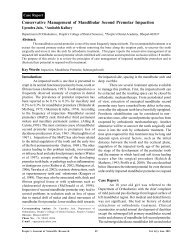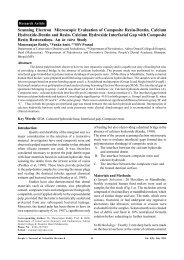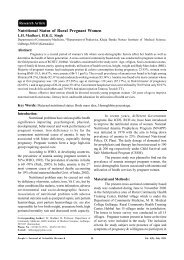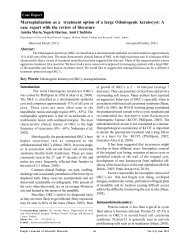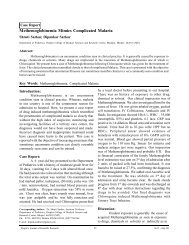full articles - pdf - People's Journal Of Scientific Research
full articles - pdf - People's Journal Of Scientific Research
full articles - pdf - People's Journal Of Scientific Research
You also want an ePaper? Increase the reach of your titles
YUMPU automatically turns print PDFs into web optimized ePapers that Google loves.
<strong>Research</strong> Article<br />
Pulmonary Functions in Trained and Untrained Wind Instrument Blowers<br />
Mohan Manohar Sagdeo, *Prashant Devidas Khuje<br />
Department of Physiology, NKP Salve Institute of Medical Sciences & <strong>Research</strong> Centre, Nagpur (M.H.), *Chirayu Medical College<br />
& Hospital, Bhopal-462030 (M.P.)<br />
(Received October, 2011) (Accepted June, 2012)<br />
Abstract:<br />
The present cross-sectional study was designed to ascertain whether regular and trained wind instrument blowers<br />
develop higher pulmonary functions than untrained or part time blowers.<br />
The study included 155 trained & regular blowers (Group A), 100 untrained part-time blowers (Group B) and 100<br />
non-blowers (Group C). They were investigated by a computerized spirometer (RMS medspiror).<br />
Group A subjects showed a significantly higher (p
Pulmonary Functions in Trained and Untrained Wind Instrument Blowers --------- M. M. Sagdeo & P. D. Khuje<br />
to testing while a non-smoker was either an ex-smoker<br />
(ceased smoking for more than a month ago) or had<br />
smoked less than 1 cigarette or bidi per day in one<br />
year or 1 cigar per week in one year (Blackburn et al,<br />
1959). Prevailing illness included any recent viral<br />
infection (within 2-3 weeks) or other acute illness<br />
(especially that involved the respiratory tract) and a<br />
serious illness such as recent myocardial infarction,<br />
pulmonary emboli, moderate to severe ascitis (Ferris,<br />
1978).<br />
The pulmonary function tests were performed<br />
by Medspiror, an automated, computerized flow sensing<br />
turbine type of Spirometer with an internal correction<br />
of volume with body temperature and pressure<br />
saturated (BTPS). All the subjects were made familiar<br />
with the procedure. The baseline data that is name,<br />
age, height, weight, body mass index, years of blowing,<br />
date of performing the test and atmospheric<br />
temperature was fed to the computerized medspiror.<br />
The test was performed in sitting position (Pierson et<br />
al, 1976). The parameters like FVC: Forced vital<br />
capacity, FEV1: Forced expiratory volume in 1 second,<br />
FEV1/FVC %: ratio of FEV1/FVC in %, FEF-25%:<br />
Forced expiratory flow of 25% of FVC, FEF-50%:<br />
Forced expiratory flow of 25% of FVC, FEF-75%:<br />
Forced expiratory flow of 75% of FVC, FEF25-75%:<br />
Forced expiratory flow between 25% & 75% of FVC,<br />
PEFR: Peak Expiratory flow rate, MVV: Maximum<br />
voluntary ventilation were recorded three times & the<br />
best of the three was noted. The percentage predicted<br />
values rather than the actual values were used for<br />
analyzing the data. The data was analyzed by using<br />
ANOVA one way for all the parameters except ‘period<br />
of blowing’ where unpaired t test was applied.<br />
Results:<br />
Out of 355 enrolled subjects, there were 255<br />
trained and untrained blowers put together. Out of 255<br />
blowers, 58 were trumpet blowers, 56 clarinet blowers,<br />
36 euphonium blowers, 30 bag pipers, 23 cornet<br />
blowers, 17 saxophone blowers, 11 trombone blowers,<br />
Table I: Age distribution of subjects in all the 3 groups.<br />
Age<br />
in Years<br />
Group A<br />
(n = 155)<br />
Group B<br />
(n = 100)<br />
Group C<br />
(n =100)<br />
20 – 30 61 (39) 32 (32%) 38 (38 %)<br />
31 – 40 62 (40%) 43 (43%) 40 (40%)<br />
41 – 50 32 (21%) 25 (25 %) 22 ( 22%)<br />
8 bugle blowers, 4 flutist, 3 each were French-horn<br />
blowers oboe blowers and bass blowers; 2 were<br />
sousaphone blowers and 1 was bassoon blower.<br />
Age wise distribution of subjects is depicted in<br />
Table I. When overall age distribution in three groups<br />
was analyzed, it was observed that the mean age of<br />
Group B (35.5 yrs) was more than Group A (33.16<br />
yrs.) and Group C (33.65 yrs). However, it was not<br />
statistically significant (p=0.0536). Basal metabolic<br />
index (BMI) was comparable in the three groups and<br />
the difference was not statically significant (p=0.3916).<br />
The mean period of blowing in years was more in<br />
Group B ( 14.08 yrs) than Group A (12.23 yrs), but the<br />
difference was not significant (p=0.0552; Table II).<br />
Table II: Mean age, BMI and period of blowing in various<br />
groups.<br />
Baseline Group A Group B Group C<br />
Parameters (n = 155) (n =100) (n =100)<br />
Age 33.16 ± 35.5 ± 33.65 ±<br />
(years) 6.77 7.74 8.14<br />
BMI 22.63 ± 22.44 ± 22.21 ±<br />
(Kg/m2) 2.17 2.82 2.18<br />
Period of<br />
blowing in 12.23± 14.08 ±<br />
years 7.23 7.78 -<br />
p value<br />
p=0.0536<br />
NS<br />
p=0.3916<br />
NS<br />
p=0.0552<br />
NS<br />
The mean predicted value of FVC, FEF25-75%, PEFR,<br />
FEF 50%, FEF 75% and MVV was significantly higher<br />
(p
Pulmonary Functions in Trained and Untrained Wind Instrument Blowers --------- M. M. Sagdeo & P. D. Khuje<br />
Table III. Spirometric parameters in all the groups<br />
Spirometric<br />
Parameters<br />
Group A<br />
(n = 155)<br />
Group B<br />
(n =100)<br />
Group C<br />
(n =100)<br />
Mean ± SD Mean ± SD Mean ± SD<br />
p value<br />
FVC (lits) 108.66 ± 12.17 104.17 ± 13.03 98.2 ± 10.87 < 0.001 *<br />
FEV1 (lits) 110.34 ± 11.48 105.89 ±11.53 100.6 ± 10.92 < 0.001*<br />
FEV1/FVC % 101.74 ± 4.95 102.03 ± 4.75 102.59 ±4.16 0.3699 NS<br />
FEF 25-75% (lits) 84.60 ± 17.8 73.55 ±9.08 71.49 ±7.45 < 0.001 *<br />
PEFR (lits) 104.61 ± 12.7 67.6 ± 10.04 67.56 ±10.49 < 0.001 *<br />
FEF 25% (lits) 96.20 ± 16.81 69.45 ±8.65 67.56 ± 8.42 0.1057 NS<br />
FEF 50% (lits) 73.83 ± 17.52 62.02 ±9.19 60.3 ± 7.45 < 0.001 *<br />
FEF 75 % (lits) 53.29 ±13.35 51.65 ±8.83 50.42 ±7.29
Pulmonary Functions in Trained and Untrained Wind Instrument Blowers --------- M. M. Sagdeo & P. D. Khuje<br />
4. Cheng YJ, Macera CA, Addy CL, Sy FS, Wieland D,<br />
Blair SN: Effects of physical activity on exercise tests<br />
and respiratory function. British <strong>Journal</strong> of Sports<br />
Medicine, 2003;37(6):521-528.<br />
5. Chen FC, Weinreich G: Nature of the lip reed. The<br />
<strong>Journal</strong> of Acoustical Society of America, 1996;<br />
99(2):1227-1233.<br />
6. Cossette I, Monaco P, Aliverti A, Mackem P: Chest wall<br />
dynamics and respiratory muscle recruitment during<br />
flute playing. The <strong>Journal</strong> of Acoustical Society of<br />
America, 2008;123(5):3241.<br />
7. Cossette I: Respiratory mechanics in professional<br />
flutist. Revue des Maladies Respiratoires, 2002;19<br />
(2):197-206.<br />
8. Ferris BG: Epidemiology standardization project<br />
(American Thoracic Society). The American Review of<br />
Respiratory Diseases, 1978;118 (6 pt-2):1-120.<br />
9. Fiz JA, Aquilar J, Carreras A, Teixido A, Haro M,<br />
Rodenstein DO, Morera J: Maximum respiratory<br />
pressures in Trumpet players. Chest, 1993;104(4):1203-<br />
1204.<br />
10. Fletcher NH: The physiological demands of wind<br />
instrument performance; Acoustics Australia<br />
2000;28(2):53-56.<br />
11. Hough A: Clinical assessment-Respiratory function<br />
Tests, Obstructive disorders & Pulmonary<br />
rehabilitation; An evidence-based approach to<br />
respiratory & cardiac management. In: Physiotherapy<br />
in respiratory care. 3 rd Edn.; Nelson Thompson Ltd.<br />
U.K. 2001; pp55-59,90-91, 232-240.<br />
12. Huang G, Li J: Study of respiratory mechanics in<br />
soldiers. Hua Xi Yi Ke Da Xua Xue Bao. (The <strong>Journal</strong><br />
of West China Medical University of Sciences),<br />
1993;24(4):409-413.<br />
13. Kahane JC, Beckford NS, Chorna LB, Teachey JC,<br />
Meclelland DK: Videofluoroscopic and Laryngoscopic<br />
evaluation of the upper airway and Larynx of<br />
professional bassoon players. <strong>Journal</strong> of Voice,<br />
2006;20(2):297-307.<br />
14. Kisner C, Colby LA: Management of pulmonary<br />
conditions, Breathing exercises & ventilation training.<br />
In: Therapeutic Exercise Foundations and techniques.<br />
5 th Edn.; E.A. Davis Company Philadelphia. 2007;<br />
pp.861-866.<br />
15. Kreuter M, Kreuter C, Herth F: Pneumological aspects<br />
of wind instrument performance-Physiological, Pathophysiological<br />
and therapeutic considerations.<br />
Pneumologie, 2008;62(2):83-87.<br />
16. MedSpiror Users guide/manual; Recorder & Medicare<br />
System, Chandigarh, India. Version 01;2004: pp5-46.<br />
17. Munn NJ, Thomas SW, De Mesquita S: Pulmonary<br />
function in commercial glass blowers. Chest<br />
1990;98(4):871-874.<br />
18. Navratil M, Rejsek K: Lung function in wind instrument<br />
players and glassblowers. Annals of New York<br />
Academy of Sciences, 1968;155(1):276-283.<br />
29. Padmavathy KM: Comparative study of pulmonary<br />
function variables in relation to the type of smoking.<br />
Indian <strong>Journal</strong> of Physiology & Pharmacology, 2008;<br />
52(2):193-196.<br />
20. Pierson DJ, Dick NP, Petty TL: A comparison of<br />
Spirometric values with subjects in standing and sitting<br />
position. Chest, 1976; 70(1):17-20.<br />
21. Schorr-Lesnick B, Teirstein AS, Brown LK, Miller A:<br />
Pulmonary function in singers and wind instrument<br />
players. Chest, 1985;88(2):201-205.<br />
22. Singh V: Pulmonary Function testing for Clinicians.<br />
Indian Asthma Care Society, Jaipur (India) 1999; p6-31.<br />
23. Wang TG, Wang YH, Tang FT, Lin KH, Lien IN: Resistive<br />
inspiratory muscle training in sleep-disordered<br />
breathing of traumatic paraplegia. Archives of Physical<br />
Medicine & Rehabilitation, 2002;83(4):491-496.<br />
24. Wanger J: Forced spirometry and related test. In:<br />
Pulmonary Function Testing: A Practical Approach.<br />
Williams & Wilkins Publication, Baltimore. 3 rd Edn.;1992;<br />
p1-70.<br />
25. Withers RT, Bourdon PC, Crockett A: Spirometric<br />
standards for healthy male lifetime non-smokers.<br />
Human Biology, 1989;61(3):327-342.<br />
26. Zuskin E, Butkovic D, Schachter EN, Mustajbegovic J:<br />
Respiratory functions in workers employed in the<br />
glassblowing industry. American <strong>Journal</strong> of Industrial<br />
Medicine, 1993; 23(6): 835-844.<br />
Source of Support : Nil.<br />
Conflict of Interest: None declared.<br />
People’s <strong>Journal</strong> of <strong>Scientific</strong> <strong>Research</strong> 12<br />
Vol. 5(2), July 2012


